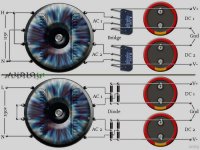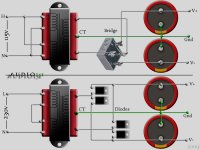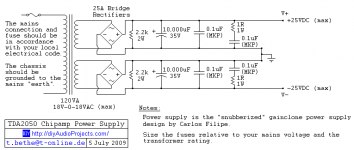Dear Sirs and Madams!
I am fairly new to electronics, but I am very keen on audio appliances. I am proud owner of Cerwin Vega DC 1515 Tower Loudspeakers and I've decided to build power amp for them. Since I am always short for Sunfire amp, I would like to build power amp on my own. Can someone give me some hints, where to start? I want to build high quality power amp and since parts can be expensive, I will buy them "per partes". Now, where to start? What "architecture" should I follow, since that my pair DC1515 (2x15" woffer) is big .
.
I am fairly new to electronics, but I am very keen on audio appliances. I am proud owner of Cerwin Vega DC 1515 Tower Loudspeakers and I've decided to build power amp for them. Since I am always short for Sunfire amp, I would like to build power amp on my own. Can someone give me some hints, where to start? I want to build high quality power amp and since parts can be expensive, I will buy them "per partes". Now, where to start? What "architecture" should I follow, since that my pair DC1515 (2x15" woffer) is big
Welcome to Diyaudio.com. Tell us more like: how much $$$ do you want to spend, How much power, what class amp etc. if you are looking for 100+ watts, you have many choices. you can get amp kits from many providers. the ones I like the most are from: Aussie amplifiers and hdamp.com.But there are many more.
Well, I thought I can spare 100-200 EUR per month for parts. I am thinking about multichannel design, where I can simply add channel pcbs into "main board" like PC computers have. Since my speakers are 600 W per speaker, 102 dB sensitity, they can handle a lot of power. I was thinking about 600 watt per channel (rms - 4 ohms), like that Bob Carver's Sunfire from 90's.Welcome to Diyaudio.com. Tell us more like: how much $$$ do you want to spend, How much power, what class amp etc. if you are looking for 100+ watts, you have many choices. you can get amp kits from many providers. the ones I like the most are from: Aussie amplifiers and hdamp.com.But there are many more.
if you want small modules, check some of these.
High End Audio MOSFET Amplifiers
They are very good. I build many amps using the NXV200. if you want to do some soldering and testing voltages etc. just get some from hdamp.com like: T300 or the M400.
High End Audio MOSFET Amplifiers
They are very good. I build many amps using the NXV200. if you want to do some soldering and testing voltages etc. just get some from hdamp.com like: T300 or the M400.
Wow, thanks, nice site! But is it possible to build one from scratch in a fashion like PC computers, for instance, one "main board" with power connectors and ISA slot, where you then add ISA PCB "power amp" channels?if you want small modules, check some of these.
High End Audio MOSFET Amplifiers
They are very good. I build many amps using the NXV200. if you want to do some soldering and testing voltages etc. just get some from hdamp.com like: T300 or the M400.
...I was thinking about 600 watt per channel (rms - 4 ohms)...
I'd respectfully suggest you start a little more modest. Even experienced builders would give something like 600W /channel some very careful consideration before undertaking the task. The cost for such an animal would be quite high, things like chassis, heat-sinking, capacitors, semiconductors et al add up quickly and almost exponentially with increasing power.
Also, at 102dB sensitivity for your speakers you likely only need 50W-100W /channel to cave your head in.
Thank you for "grounding me". Ok, but let's get to theory. I know about rectifier, blocking capacitors, since I've built bench PSU for hobby needs (+5V, +/-12V, +3.3V 1A outputs + one variable with LM317), what are main differences with such PSU and audio power amp PSU?I'd respectfully suggest you start a little more modest. Even experienced builders would give something like 600W /channel some very careful consideration before undertaking the task. The cost for such an animal would be quite high, things like chassis, heat-sinking, capacitors, semiconductors et al add up quickly and almost exponentially with increasing power.
Also, at 102dB sensitivity for your speakers you likely only need 50W-100W /channel to cave your head in.
I'd respectfully suggest you start a little more modest. Even experienced builders would give something like 600W /channel some very careful consideration before undertaking the task. The cost for such an animal would be quite high, things like chassis, heat-sinking, capacitors, semiconductors et al add up quickly and almost exponentially with increasing power.
Also, at 102dB sensitivity for your speakers you likely only need 50W-100W /channel to cave your head in.
I agree! 100 watts RMS per channel will be more than enough!!!
A typical power amp PSU is unregulated - just transformer, bridge rectifier, capacitors. Typically a lot of capacitance for instantaneous current demands. It's also symmetrical. For a 100W amp you are looking at +/- 55V supplies, at least 300VA transformer, probably at least 10,000uF capacitor per rail.
Wow, thanks, nice site! But is it possible to build one from scratch in a fashion like PC computers, for instance, one "main board" with power connectors and ISA slot, where you then add ISA PCB "power amp" channels?
These modules from Aussie amplifiers are ready made and tested, you just need to connect a power supply. you can add as many as you want. as long as you have the right power supply. 100 watts RMS per channel is a lot of power. beside your speakers have high SPL.
Thank you for "grounding me". Ok, but let's get to theory. I know about rectifier, blocking capacitors, since I've built bench PSU for hobby needs (+5V, +/-12V, +3.3V 1A outputs + one variable with LM317), what are main differences with such PSU and audio power amp PSU?
You can read here for some info on amp power supply.
Solid State Power Amplifier Supply Part 1
Thank you for "grounding me". Ok, but let's get to theory. I know about rectifier, blocking capacitors, since I've built bench PSU for hobby needs (+5V, +/-12V, +3.3V 1A outputs + one variable with LM317), what are main differences with such PSU and audio power amp PSU?
The differences, in theory, are minimal. The main issue is scale. Your rails will be much higher than for a typical hobby bench supply. The currents involved can run into tens of amperes when looking at charging currents and ripple currents. Mercifully we typically DO NOT use active regulation for amplifier designs, so at least you aren't tasked with creating a high voltage / high current regulator (x2 rails no less). Things like grounding become critical and must be considered with care to avoid loops and injecting noise from large current pulses into the audio path.
The schematic for a basic audio PSU will look quite simple. The devil will be in the details of its layout and execution.
- Status
- This old topic is closed. If you want to reopen this topic, contact a moderator using the "Report Post" button.
- Home
- Amplifiers
- Solid State
- [NEWBIE]Amplifier Design[NEWBIE]


